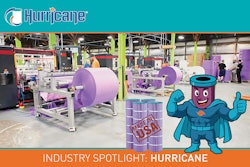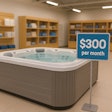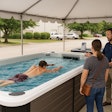
"Our technicians are very helpful and very knowledgeable, so they'll go out there and, if the heater is down and doesn't have a warranty on it and it's going to be an out-of-pocket expense for the customer, they'll tell them the options," says Christian Robichaud, service manager for Colley's Pools & Spas, a retail, service and pool-building operation in Hamburg, N.Y. "And, for the most part, we can repair whatever is wrong with the heater, but we'll give them the option of replacement. 'Hey, this heater is pretty old. You're looking at a $1,000 repair. For $2,500 you can get a new heater that'll be more efficient and will save you money in the long run on repairs.'
"Some people choose to keep adding more parts in, though. It's like a car. If you have an old heater and you keep adding part after part after part, before you know it, after a year or two of repairs, you could have bought a new heater for what you've spent."
For the service department manager or store owner, it makes little difference which route the customer chooses, as he'll make money up front or over time. What matters is acting in the customer's best interest, something your service technicians are likely to recognize if they're doing their jobs well and gaining the customer's trust. That's what they do at Tubs of Fun! in Fargo, N.D., and company president Troy Derheim says it's an effective approach.
"I try to get them to really walk through the process with them," he says. "I explain to my guys that we're not just out there trying to make sales; it's a matter of being a partner with the customer. Walk them through it and educate them about the options."
Wayne George is vice president and co-owner in Maryland Heights, Mo.-based Westport Pools and Midwest Pool Management, a company with a similar approach to partnering with its clients.
"In our experience, our customers usually rely on our suggestions," he explains. "They'll ask, 'What do you think? Tell us what we need to do. We don't want to see it, we don't want to hear it and we don't want to think about it, but we don't want to be buying a new heater every five years, either.' So most of our clients are pretty receptive to our ideas."
Partnership
Derheim's approach to this partnership is methodical and is first evident in the spring, during pool-opening season.
"We'll do a diagnostic that goes through and checks all the components in the system - not just the heater - and gives them a rating, basically," he says. "Something might rate an 8, so they're doing pretty good there. Another part might rate a 2, and we'll tell them, 'You might make it through the season, but don't be surprised if you're going to need repairs. Would you like to do something about that now?'"
That's pretty much what they do at Wight Water Pools in Fresno, Calif., too.
"We'll do what we call a PM - preventative maintenance - check," says company president Jon Heffernan. "We'll pull out the burners, clean them, clean out any leaves or other debris on the heat exchanger, blow out the pilot tubes and clean them out, adjust the pilot and the igniter. We'll do that about once a year, like they recommend in the heating and AC industry."
Preventative Maintenance
The idea service pros are most emphatic about is the importance of maintaining proper chemistry inside the pool in order to prevent problems in the first place. It's the failure to do this that leads to the most-expensive heater breakdown - a bad heat exchanger.
"Most of the big problems we see with heaters occur because the pH just gets too low," George explains. "And any time the pH gets low, you get an acidic condition, and it doesn't take long for that heat exchanger, or tube bundle, as we call it, to get damaged beyond repair. The tube bundles are made of copper, which is a very, very soft metal."
Once that copper is breached, that acidic water is free to find its way outside the tube bundles and onto the heating coils, resulting in catastrophic heater failure.
Heaters with bad exchangers can be fixed, but it's a costly repair.
"If the heat exchanger goes out, that's a huge cost right there and it's better to just change it out, unless the heater is pretty new," says Heffernan. "So considering the cost of it and the energy that consumers will save, in most cases the consumer will end up replacing the heater versus fixing the older one."
In Derheim's experience, the efficiency angle Heffernan pursues is a good one, and it could sell a fence-sitter on a new heater now and again, but for the most part, people he deals with just want heaters that work.
"You get a few customers that really want to know the details on the payback, but most people just want a solution," Derheim says. "But there's such a difference in the product now compared to the past. I think it was the threat of efficiency standards a few years back that made all the manufacturers step up and make big improvements in the heating components. The California law is a wave that's going to come across the whole country."
Sticks, Stones
Another common and easily avoided heater problem arises when leaves, sticks and other backyard debris are allowed to gather on and around the unit.
George recalls a recent service call he made on a relatively new heater for a poorly informed homeowner whose hands-off attitude toward the heater proved costly.
"We went out to this guy's house and he had about a 4-year-old heater," he says. "We waded through a foot of leaves, took the door off, and the whole burner tray was just absolutely rotten. Leaves had packed around the bottom of the heater, so it wasn't venting. It was off for the winter, but it wasn't getting any airflow through it. It also had water coming in and nowhere for the water to go. So all that moisture and rot was building up inside that cabinet and it just destroyed a fairly new heater."
In addition to blocking airflow, a pileup of leaves and twigs on and around a pool heater provides an inviting home for rodents, even in warmer parts of the country.
"When leaves and other debris pile up on the heater, rats will find that it makes a good nest," says Heffernan. "They'll eat the wires, tear apart the insulation to create their nests. Then, when the customer goes to fire it up in the spring they'll discover it's no longer working."
In these cases, something as simple as a rake and five minutes of work would have saved the customer's equipment. He's not going to know that instinctively, though. You've got to tell him.
"It's really just kind of basic maintenance," George says, "but if you're not aware of it . . ."
Minor Repairs That Mount
Other heater problems are less traumatic, but tend to add up as the heater ages. Imagine a '92 Taurus with a bad air conditioner, shocks and belts. Hardly worth fixing. (It's hard not to frame these things in the more-familiar terms of car repair. Everyone we spoke with did it.)
"There are a lot of smaller things that go wrong," says Robichaud. "Things like fuses, which are the best thing that can go wrong because they're cheap. Or the pressure switch. Those we'll always repair."
It's when a manifold or gas valve gives out that the customer's got a real decision to make, according to Derheim.
"That's when we'll have the conversation about whether they want to put in $600 to $800, or up to $1,000 with everything into a repair," he says, "or whether it's time to just bite the bullet and get a whole new heater."
Whether it's a major malfunction or a laundry list of smaller fixes that piles up, there comes a time in every heater's life when there's little question that it's time to throw in the towel and just get a new one.
"I think if you've got an 8-year-old heater, you've really gotten your money out of it, and if something big goes wrong, it's time to get a new one," says Derheim. "I have some customers who've had heaters for 15 years, but on the average, you see 8 to 12. With good care you should be able to get that easily. On the other hand, I've seen customers wear them out in just a year or two."
Robichaud pegs a well-cared-for heater's life expectancy at around 10 years, though he's seen some as old as 25. Like the others, he recommends swapping an older heater out for a new one once something major needs fixing or smaller repairs begin to mount. His customers understand the idea, but lately not all of them follow his advice. Sometimes, that's out of stubbornness, and sometimes it's necessity.
"They understand it's in their best interest to get a new heater," he says, "but not too many people have the extra $2,500 or $3,000 to put a new heater in. They'd rather make a $600 repair, even if in the long run it's not the best solution. It's just a quick fix for the rest of the season. We've been seeing more of that."
For customers who are more amenable to the idea of replacement, today's heaters feature several improvements over older models that can help sweeten the sales pitch.
"There have been a number of improvements that have been made that we'll discuss with folks," says George. "There's the low-NOx stuff, the energy efficiency and even an upgrade to a heat exchanger called a cupronickel heat exchanger."
George's use of the work "cupronickel" draws a comment from vice president Dave White, who's in on a conference call: "Easy for you to say."
"Yeah," George responds, laughing himself. "Cupronickel. It's a little more expensive, but it's a heavier-duty tube bundle. It's not solid copper; it's got a little nickel in it, which makes it more forgiving of bad chemistry.
"Usually we sell that the second time around, not the first."
Comments or thoughts on this article? Please e-mail [email protected].
A Dying Breed
Is the pool-only heater in California an endangered species?
Jon Heffernan is president of Wight Water Pools, a service company with about 150 customers in and around Fresno and Madera in central California. Most of the heater calls he gets are for inground custom spas or pool-and-spa combos, but he does occasionally get a call on an old pool-only heater.
"There aren't too many heaters on pools here anymore," he says. "There are a lot of older pools that still have heaters, because when gas and electricity were relatively inexpensive, they were installing them like crazy, but ever since the cost has jumped up so much, even our high-end clients won't run heaters on their pools during the wintertime. It's just too expensive."
Heffernan recalls one well-heeled client with an indoor pool who recently fired up his heater.
"This was a million-dollar house," he says. "The guy built the pool and put a heater on there, and he tried to heat the pool one time for his kid's birthday. And it was even too costly for him, so he just stopped using it completely.
"If someone at the high end can't afford it, there's no way the average pool owner could."
Asked whether clients with broken pool heaters opt to replace them or just get rid of them, Heffernan says that's never in question.
"The heaters are just sitting there not being used," he explains. "A lot of times we'll just remove them and loop the line. It makes the pool more efficient because the water gets bypassed instead of going through the heater."
- B.K.











































